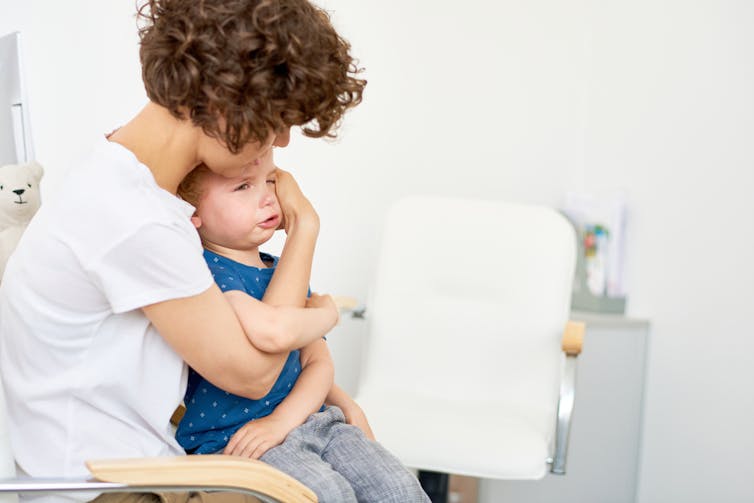
Lucy Bray, Edge Hill University and Bernie Carter, Edge Hill University
When children go to hospital they enter a strange place. It’s an unfamiliar building that sounds and smells unusual, full of strangers and intimidating equipment. This can be overwhelming and can make them feel small and anxious. Children cannot always find a way to say that they are scared or worried about having a simple procedure such as an X-ray or blood test so they show their feelings through crying or refusing to have the procedure done.
This does not always happen, as many parents and professionals are skilled at using creative methods such as play, books and technology, to prepare and distract a child and help them have a good experience of having a procedure.
However, we know from our work that a child who says “no”, “stop” or “wait” is not always listened to and a child kicking out, crying or trying to wriggle away is not always taken as a sign by parents or professionals to stop.
In our study, we observed 31 procedures undertaken in a children’s hospital and interviewed the health professionals, parents and children. In many of the cases the child was held in order to “get the procedure done quickly”.
Often, especially with young children, a parent or health professional will hold a child to make sure the procedure is completed. This may be a parent giving their child a “tight hug” on their knee or in some cases may involve a child having their arms and legs held by parents and health professionals. This holding of children to get procedures done is not something that happens once in a while, it happens often within healthcare. The majority of health professionals (81%) in our international questionnaire reported that children are held for procedures frequently or very frequently.

‘Upsetting and stressful’
Most parents will remember holding their child for a procedure at some stage in their lives, whether this was for an immunisation, examination or procedure. In many cases parents feel that being with their child is important and being the one to hold them feels supportive. Parents want to do “whatever it takes” for their child. But some parents are “surprised” at being asked to hold their child and can find it “upsetting and stressful” if they end up having to hold them forcefully.
Our research shows that professionals can also feel upset. One professional told us: “Sometimes you think you might have gone a little bit too far, you do think …‘I don’t like the fact that I had to hold her so tight’”. Most importantly being forcefully held can cause a child to be scared of coming to hospital and having procedures in the future. They can even experience psychological trauma and harm.
Is the procedure urgent?
Each situation that may lead to a child being held is unique and presents a particular set of circumstances. In some cases, when a child is very poorly or unwell and a procedure or treatment is urgent then it may be justifiable to hold a child who is resisting and asking for it to stop.
But the decision to hold a child who is sobbing and clearly upset is more difficult to justify if the procedure is not urgent. Health professionals and parents make a quick on the spot decision whether to hold a child to get a procedure done. We found that parents and health professionals can become too focused on getting a procedure done and neglect to take a minute to think if there is a different way.
Each child has a right to express their dissent through words like “stop” or by pushing people away. When this happens they should be listened to – not simply ignored and held more tightly.
The Rights of the Child
Children have rights, acknowledged by the United Nations Convention on the Rights of the Child. The convention outlines how children have a right to be protected from harm and the right to an opinion. More importantly, they have a right for this opinion to be listened to and taken seriously.
Professional guidance states that holding a child for a procedure should be a “last resort” after all other means of preparation and distraction have been tried. Our work shows that holding children for non-urgent procedures is not always a last resort. It continues to be a part of everyday practice that impacts on everyone involved. Our research is looking at how to develop resources and new interventions to help avoid this.
![]() Changing practice requires each and every one of us to challenge how taken for granted the use of holding is. Using creative methods to prepare children for procedures and supporting children throughout can do a great deal to reduce the need for forceful holding and reduce the stress and trauma which can be experienced by children, parents and health professionals.
Changing practice requires each and every one of us to challenge how taken for granted the use of holding is. Using creative methods to prepare children for procedures and supporting children throughout can do a great deal to reduce the need for forceful holding and reduce the stress and trauma which can be experienced by children, parents and health professionals.
Lucy Bray, Professor in Child Health Literacy, Edge Hill University and Bernie Carter, Professor of Children’s Nursing, Edge Hill University
This article was originally published on The Conversation. Read the original article.
